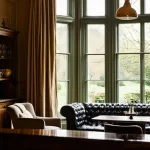Essential Considerations for Choosing a Color Palette in UK Homes
Selecting a UK home color palette requires careful attention to local lighting conditions. The UK’s often overcast climate means natural light can be limited and diffuse. Therefore, when choosing paint colors UK, it is crucial to consider how light interacts with hues throughout the day. Lighter shades can brighten rooms that lack sunlight, while darker colors might absorb too much light, making spaces feel cramped.
British interiors advice often highlights the influence of traditional architectural styles such as Victorian, Georgian, and Edwardian homes. These styles frequently feature period-specific color schemes and materials. For example, classic sash windows and ornate molding pair well with muted, historic tones. Recognizing the character of your home helps guide an appropriate color palette that respects its heritage while maintaining a fresh appearance.
Additional reading : How can you personalize your UK home with unique art pieces?
Moreover, the weather and seasonal changes affect both interior and exterior paint performance. Dampness and fluctuating temperatures may cause fading, peeling, or damp-related discoloration. Hence, selecting weather-resistant exterior paints and ensuring interior colors complement seasonal shifts enhances longevity and aesthetic appeal. These considerations are pivotal in creating a balanced and enduring UK home color palette.
Step-by-Step Process for Selecting Interior Colors
When choosing interior color schemes UK homeowners should start by evaluating the room’s function and the mood they want to create. For example, calming blues and greens work well in bedrooms to promote relaxation, while vibrant hues suit living areas where energy and socialising are encouraged. Thinking about the room’s purpose helps narrow down choices tailored to everyday use and personal comfort.
Also read : What are the best ways to incorporate vintage style in UK interiors?
Next, sampling colors is crucial, particularly because UK lighting conditions can vary significantly throughout the day and season. Paint testers allow you to observe how colors shift in natural daylight and artificial lighting. This step avoids surprises and ensures the color retains its intended effect in different parts of the day, which is vital when you want to make a lasting impression with your paint.
Finally, harmonising new colors with existing furnishings and finishes enhances cohesion. Whether it’s matching with classic British hardwood floors or complementing fabric textures, choosing paint that complements your current décor maintains a seamless and stylish UK home style. Balancing walls with furniture tones can uplift the entire interior without overwhelming the senses.
Exterior Color Palette Recommendations for UK Properties
Choosing the right exterior house colors UK involves balancing aesthetic appeal with practical concerns such as compliance with local planning rules. Many British councils enforce guidelines to maintain the character of neighbourhoods, often favoring traditional shades over bold modern hues. Understanding these rules upfront can save homeowners from costly repainting or fines.
The UK’s variable climate necessitates exterior paint choices that withstand dampness and temperature fluctuations. Paints with mildew resistance and weatherproof qualities are essential for enduring wet conditions typical across Britain.
For those undecided between traditional vs modern color choices, timeless palettes remain favored. Popular selections often include soft creams, muted blues, gentle greys, and classic whites. These shades complement the classic British brick or stone façade while adding subtle charm. More adventurous homeowners may incorporate contemporary slate greys or rich navy blues, provided local guidelines allow.
Avoiding common pitfalls requires considering how colors age in UK light and weather. Overly dark tones absorb moisture and can reveal fading or mould more quickly. Likewise, loud, bright colours tend to clash in traditional neighbourhoods and may stand out in planning reviews.
In summary, selecting exterior colors requires attention to British home exteriors’ character, climate adaptability, and local regulations. A well-chosen palette enhances curb appeal and long-term durability, blending tradition with individual style.
Expert Tips and Do’s & Don’ts for UK Home Color Choices
Choosing the right color palette can transform your UK home, but it requires professional decorating advice UK to avoid common pitfalls. A key color palette mistake is overusing dark colors in small rooms, which can make spaces feel cramped and gloomy. Instead, embrace lighter shades or muted tones that reflect natural light, enhancing the room’s sense of space and warmth.
When incorporating UK color trends, consider classic British colors like deep navy, soft sage green, or warm cream. These tones offer timeless appeal, combining tradition with a fresh, modern touch. Trend-led palettes often mix these with bold accents such as mustard or blush pink, which can add character without overwhelming the room.
Avoid clashing palettes; for example, mixing too many bold colors can create visual chaos. Instead, use complementary shades to establish harmony. Leverage color strategically—warm hues in living areas create cozy atmospheres, while cooler tones in bedrooms promote relaxation. For kitchens, brighter tones can invigorate the space.
By using expert decorating advice UK and carefully balancing color combinations suited to your room’s purpose, you can confidently update your home with style and personality.
Inspiring Color Palette Ideas for Different UK Home Types
Choosing the right color palette ideas UK depends heavily on your home’s architectural style. For Victorian and Edwardian homes, classic palettes feature muted, earthy tones—think deep greens, rich burgundies, and warm creams. These hues enhance ornate details and high ceilings, lending elegance without overwhelming the space. Using these colors helps retain the period charm that defines such homes.
In contrast, contemporary UK interiors thrive on clean, neutral palettes with pops of bold color for impact. Soft grays, crisp whites, and cool blues create a serene backdrop, ideal for minimalist décor. Incorporating accent walls or colorful furnishings invites personality while keeping spaces airy and modern.
When deciding on schemes, size plays a crucial role. In small spaces, lighter tones like soft ivories or pale blues can expand the room visually. Conversely, larger rooms can handle darker, more saturated colors to add warmth and coziness. Whether your home is historic or new build, tailoring your palette to both architectural style and room size ensures a harmonious and inviting environment.
Features to Consider in a Robot Hoover
Choosing the right robot hoover depends heavily on the features it offers. Key aspects to look for include suction power, battery life, navigation technology, and compatibility with your home’s layout. Models with enhanced suction power are ideal for homes with pets or carpets, as they can efficiently pick up hair and dirt.
Battery life determines how long a robot hoover can clean before needing a recharge. For larger homes, extended battery performance is crucial to complete cleaning cycles without interruption. Modern models often return to their charging docks automatically, ensuring minimal user effort.
Navigation technology varies from simple random patterns to advanced mapping systems. The latter allows the robot hoover to create a floor plan, clean methodically, and avoid obstacles. This feature is particularly helpful in cluttered rooms or multi-level homes.
Additionally, consider the device’s noise level and the ease of emptying its dustbin. Some models include washable filters and allergen-trapping features, beneficial for sensitive households. Exploring these features thoroughly will help you select a robot hoover that aligns perfectly with your cleaning needs.




